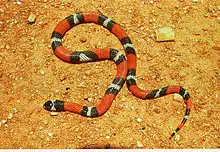Erythrolamprus aesculapii
Erythrolamprus aesculapii, commonly known as the false coral, boicora, or falsa coral, is a colubrid snake endemic to South America.[3]
| Erythrolamprus aesculapii | |
|---|---|
 | |
| Scientific classification | |
| Kingdom: | Animalia |
| Phylum: | Chordata |
| Class: | Reptilia |
| Order: | Squamata |
| Suborder: | Serpentes |
| Family: | Colubridae |
| Genus: | Erythrolamprus |
| Species: | E. aesculapii |
| Binomial name | |
| Erythrolamprus aesculapii | |
| Synonyms[2] | |
| |
Geographic range
It is found in the Amazon rainforest of South America.[3][4]
It is also found on the island of Trinidad (in the Republic of Trinidad and Tobago).[5]
Habitat
It is often found in the leaf litter or burrowing in the soil in rain forests.[3]
Diet
It feeds mainly on other snakes, including venomous species.[3]
Venom
This snake is mildly venomous.[5]
Mimicry
The brightly colored, ringed patterns of snakes of the genus Erythrolamprus resemble those of sympatric coral snakes of the genus Micrurus, and it has been suggested that this is due to mimicry. Whether this is classical Batesian mimicry, classical Müllerian mimicry, a modified form of Müllerian mimicry, or no mimicry at all, remains to be proven.[6]
Subspecies
The following four subspecies are recognized, including the nominotypical subspecies:[1]
- Erythrolamprus aesculapii aesculapii (Linnaeus, 1758) - Amazon River Basin
- Erythrolamprus aesculapii monozonus Jan, 1863 - Brazil (Bahia state to Rio de Janeiro state)
- Erythrolamprus aesculapii tetrazonus Jan, 1863 - southwestern Bolivia
- Erythrolamprus aesculapii venustissimus (Wied, 1821) - eastern Bolivia to southeastern Brazil and northeastern Argentina[3]
References
- "Erythrolamprus aesculapii ". ITIS (Integrated Taxonomic Information Sysyem). www.itis.gov.
- Boulenger GA (1896). Catalogue of the Snakes in the British Museum (Natural History). Volume III., Containing the Colubridæ (Opisthoglyphæ and Proteroglyphæ),... London: Trustees of the British Museum (Natural History). (Taylor and Francis, Printers.) xiv + 727 pp. + Plates I-XXV. (Erthrolamprus æsculapii, pp. 200-204).
- Freiberg M (1982). Snakes of South America. Hong Kong: T.F.H. Publications. 189 pp. ISBN 0-87666-912-7. (Erythrolamprus aesculapii, pp. 66, 98, 132 + photograph on p. 42 + line drawing of head scalation on p. 67).
- Cole CJ, Townsend CR, Reynolds RP, MacCulloch RD, Lathrop A (2013). "Amphibians and reptiles of Guyana, South America: Illustrated keys, annotated species accounts, and a biogeographic synopsis". Proceedings of the Biological Society of Washington. 125: 317–620. doi:10.2988/0006-324x-125.4.317.
- Erythrolamprus aesculapii at the Reptarium.cz Reptile Database. Accessed 25 August 2014.
- Goin CJ, Goin OB, Zug GR (1978). Introduction to Herpetology, Third Edition. San Francisco: W.H. Freeman. xi + 378 pp. ISBN 0-7167-0020-4. (Mimicry in Erythrolamprus, p. 159).
Further reading
- Boos, Hans E. A. (2001). The Snakes of Trinidad and Tobago. College Station, Texas: Texas A&M University Press. xvi + 328 pp. ISBN 1-58544-116-3.
- Linnaeus L (1758). Systema naturæ per regna tria naturæ, secundum classes, ordines, genera, species, cum characteribus, diferentiis, synonymis, locis. Tomus I. Editio Decima, Reformata. Stockholm: L.Salvius. 824 pp. (Coluber æsculapii, new species, p. 220). (in Latin).
- Wickler, Wolfgang (1968). Mimicry in Plants and Animals. McGraw-Hill Book Company. ASIN B00221P5R8.